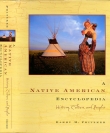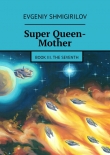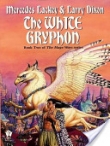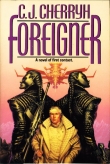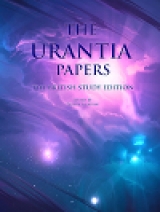
Текст книги "The British Study Edition of the Urantia Papers"
Автор книги: Tigran Aivazian
Жанр:
Религия
сообщить о нарушении
Текущая страница: 24 (всего у книги 295 страниц)
PAPER № 15
THE SEVEN SUPERUNIVERSES
Universal Censor
15:0.1 As far as the Universal Father is concerned – as a Father – the universes are virtually nonexistent; he deals with personalities; he is the Father of personalities. As far as the Eternal Son and the Infinite Spirit are concerned – as creator partners – the universes are localized and individual under the joint rule of the Creator Sons and the Creative Spirits. As far as the Paradise Trinity is concerned, outside Havona there are just seven inhabited universes, the seven superuniverses which hold jurisdiction over the circle of the first post-Havona space level. The Seven Master Spirits radiate their influence out from the central Isle, thus constituting the vast creation one gigantic wheel, the hub being the eternal Isle of Paradise, the seven spokes the radiations of the Seven Master Spirits, the rim the outer regions of the grand universe.
15:0.2 Early in the materialization of the universal creation the sevenfold scheme of the superuniverse organization and government was formulated. The first post-Havona creation was divided into seven stupendous segments, and the headquarters worlds of these superuniverse governments were designed and constructed. The present scheme of administration has existed from near eternity, and the rulers of these seven superuniverses are rightly called Ancients of Days.
15:0.3 Of the vast body of knowledge concerning the superuniverses, I can hope to tell you little, but there is operative throughout these realms a technique of intelligent control for both physical and spiritual forces, and the universal gravity presences there function in majestic power and perfect harmony. It is important first to gain an adequate idea of the physical constitution and material organization of the superuniverse domains, for then you will be the better prepared to grasp the significance of the marvellous organization provided for their spiritual government and for the intellectual advancement of the will creatures who dwell on the myriads of inhabited planets scattered hither and yon throughout these seven superuniverses.
1. THE SUPERUNIVERSE SPACE LEVEL15:1.1 Within the limited range of the records, observations, and memories of the generations of a million or a billion of your short years, to all practical intents and purposes, Urantia and the universe to which it belongs are experiencing the adventure of one long and uncharted plunge into new space; but according to the records of Uversa, in accordance with older observations, in harmony with the more extensive experience and calculations of our order, and as a result of conclusions based on these and other findings, we know that the universes are engaged in an orderly, well-understood, and perfectly controlled processional, swinging in majestic grandeur around the First Great Source and Centre and his residential universe.
15:1.2 We have long since discovered that the seven superuniverses traverse a great ellipse, a gigantic and elongated circle. Your solar system and other worlds of time are not plunging headlong, without chart and compass, into unmapped space. The local universe to which your system belongs is pursuing a definite and well-understood counterclockwise course around the vast swing that encircles the central universe. This cosmic path is well charted and is just as thoroughly known to the superuniverse star observers as the orbits of the planets constituting your solar system are known to Urantia astronomers.
15:1.3 Urantia is situated in a local universe and a superuniverse not fully organized, and your local universe is in immediate proximity to numerous partially completed physical creations. You belong to one of the relatively recent universes. But you are not, today, plunging on wildly into uncharted space nor swinging out blindly into unknown regions. You are following the orderly and predetermined path of the superuniverse space level. You are now passing through the very same space that your planetary system, or its predecessors, traversed ages ago; and some day in the remote future your system, or its successors, will again traverse the identical space through which you are now so swiftly plunging.
15:1.4 ¶ In this age and as direction is regarded on Urantia, superuniverse number one swings almost due north, approximately opposite, in an easterly direction, to the Paradise residence of the Great Sources and Centres and the central universe of Havona. This position, with the corresponding one to the west, represents the nearest physical approach of the spheres of time to the eternal Isle. Superuniverse number two is in the north, preparing for the westward swing, while number three now holds the northernmost segment of the great space path, having already turned into the bend leading to the southerly plunge. Number four is on the comparatively straightaway southerly flight, the advance regions now approaching opposition to the Great Centres. Number five has about left its position opposite the Centre of Centres while continuing on the direct southerly course just preceding the eastward swing; number six occupies most of the southern curve, the segment from which your superuniverse has nearly passed.
15:1.5 Your local universe of Nebadon belongs to Orvonton, the seventh superuniverse, which swings on between superuniverses one and six, having not long since (as we reckon time) turned the south-eastern bend of the superuniverse space level. Today, the solar system to which Urantia belongs is a few billion years past the swing around the southern curvature so that you are just now advancing beyond the south-eastern bend and are moving swiftly through the long and comparatively straightaway northern path. For untold ages Orvonton will pursue this almost direct northerly course.
15:1.6 Urantia belongs to a system which is well out towards the borderland of your local universe; and your local universe is at present traversing the periphery of Orvonton. Beyond you there are still others, but you are far removed in space from those physical systems which swing around the great circle in comparative proximity to the Great Source and Centre.
2. ORGANIZATION OF THE SUPERUNIVERSES15:2.1 Only the Universal Father knows the location and actual number of inhabited worlds in space; he calls them all by name and number. I can give only the approximate number of inhabited or inhabitable planets, for some local universes have more worlds suitable for intelligent life than others. Nor have all projected local universes been organized. Therefore the estimates which I offer are solely for the purpose of affording some idea of the immensity of the material creation.
15:2.2 ¶ There are seven superuniverses in the grand universe, and they are constituted approximately as follows:
15:2.3 1. The System. The basic unit of the supergovernment consists of about 1,000 inhabited or inhabitable worlds. Blazing suns, cold worlds, planets too near the hot suns, and other spheres not suitable for creature habitation are not included in this group. These 1,000 worlds adapted to support life are called a system, but in the younger systems only a comparatively small number of these worlds may be inhabited. Each inhabited planet is presided over by a Planetary Prince, and each local system has an architectural sphere as its headquarters and is ruled by a System Sovereign.
15:2.4 2. The Constellation. 100 systems (about 105 inhabitable planets) make up a constellation. Each constellation has an architectural headquarters sphere and is presided over by three Vorondadek Sons, the Most Highs. Each constellation also has a Faithful of Days in observation, an ambassador of the Paradise Trinity.
15:2.5 3. The Local Universe. 100 constellations (about 107 inhabitable planets) constitute a local universe. Each local universe has a magnificent architectural headquarters world and is ruled by one of the co-ordinate Creator Sons of God of the order of Michael. Each universe is blessed by the presence of a Union of Days, a representative of the Paradise Trinity.
15:2.6 4. The Minor Sector. 100 local universes (about 109 inhabitable planets) constitute a minor sector of the superuniverse government; it has a wonderful headquarters world, wherefrom its rulers, the Recents of Days, administer the affairs of the minor sector. There are three Recents of Days, Supreme Trinity Personalities, on each minor sector headquarters.
15:2.7 5. The Major Sector. 100 minor sectors (about 1011 inhabitable worlds) make one major sector. Each major sector is provided with a superb headquarters and is presided over by three Perfections of Days, Supreme Trinity Personalities.
15:2.8 6. The Superuniverse. 10 major sectors (about 1012 inhabitable planets) constitute a superuniverse. Each superuniverse is provided with an enormous and glorious headquarters world and is ruled by three Ancients of Days.
15:2.9 7. The Grand Universe. Seven superuniverses make up the present organized grand universe, consisting of approximately seven trillion inhabitable worlds plus the architectural spheres and the one billion inhabited spheres of Havona. The superuniverses are ruled and administered indirectly and reflectively from Paradise by the Seven Master Spirits. The billion worlds of Havona are directly administered by the Eternals of Days, one such Supreme Trinity Personality presiding over each of these perfect spheres.
15:2.10 ¶ Excluding the Paradise-Havona spheres, the plan of universe organization provides for the following units:
15:2.11 Superuniverses: 7
15:2.12 Major sectors: 70
15:2.13 Minor sectors: 7·103
15:2.14 Local universes: 7·105
15:2.15 Constellations: 7·107
15:2.16 Local systems: 7·109
15:2.17 Inhabitable planets: 7·1012
15:2.18 Each of the seven superuniverses is constituted, approximately, as follows:
15:2.19 One system embraces, approximately 103 worlds
15:2.20 One constellation (100 systems) 105 worlds
15:2.21 One universe (100 constellations) 107 worlds
15:2.22 One minor sector (100 universes) 109 worlds
15:2.23 One major sector (100 minor sectors) 1011 worlds
15:2.24 One superuniverse (10 major sectors) 1012 worlds
15:2.25 ¶ All such estimates are approximations at best, for new systems are constantly evolving while other organizations are temporarily passing out of material existence.
3. THE SUPERUNIVERSE OF ORVONTON15:3.1 Practically all of the starry realms visible to the naked eye on Urantia belong to the seventh section of the grand universe, the superuniverse of Orvonton. The vast Milky Way starry system represents the central nucleus of Orvonton, being largely beyond the borders of your local universe. This great aggregation of suns, dark islands of space, double stars, globular clusters, star clouds, spiral and other nebulae, together with myriads of individual planets, forms a watchlike, elongated-circular grouping of about 1/7th of the inhabited evolutionary universes.
15:3.2 From the astronomical position of Urantia, as you look through the cross section of near-by systems to the great Milky Way, you observe that the spheres of Orvonton are travelling in a vast elongated plane, the breadth being far greater than the thickness and the length far greater than the breadth.
15:3.3 Observation of the so-called Milky Way discloses the comparative increase in Orvonton stellar density when the heavens are viewed in one direction, while on either side the density diminishes; the number of stars and other spheres decreases away from the chief plane of our material superuniverse. When the angle of observation is propitious, gazing through the main body of this realm of maximum density, you are looking toward the residential universe and the centre of all things.
15:3.4 ¶ Of the ten major divisions of Orvonton, eight have been roughly identified by Urantian astronomers. The other two are difficult of separate recognition because you are obliged to view these phenomena from the inside. If you could look upon the superuniverse of Orvonton from a position far-distant in space, you would immediately recognize the ten major sectors of the seventh galaxy.
15:3.5 The rotational centre of your minor sector is situated far away in the enormous and dense star cloud of Sagittarius, around which your local universe and its associated creations all move, and from opposite sides of the vast Sagittarius subgalactic system you may observe two great streams of star clouds emerging in stupendous stellar coils.
15:3.6 The nucleus of the physical system to which your sun and its associated planets belong is the centre of the onetime Andronover nebula. This former spiral nebula was slightly distorted by the gravity disruptions associated with the events which were attendant upon the birth of your solar system, and which were occasioned by the near approach of a large neighbouring nebula. This near collision changed Andronover into a somewhat globular aggregation but did not wholly destroy the two-way procession of the suns and their associated physical groups. Your solar system now occupies a fairly central position in one of the arms of this distorted spiral, situated about halfway from the centre out towards the edge of the star stream.
15:3.7 ¶ The Sagittarius sector and all other sectors and divisions of Orvonton are in rotation around Uversa, and some of the confusion of Urantian star observers arises out of the illusions and relative distortions produced by the following multiple revolutionary movements:
15:3.8 1. The revolution of Urantia around its sun.
15:3.9 2. The circuit of your solar system about the nucleus of the former Andronover nebula.
15:3.10 3. The rotation of the Andronover stellar family and the associated clusters about the composite rotation-gravity centre of the star cloud of Nebadon.
15:3.11 4. The swing of the local star cloud of Nebadon and its associated creations around the Sagittarius centre of their minor sector.
15:3.12 5. The rotation of 100 minor sectors, including Sagittarius, about their major sector.
15:3.13 6. The whirl of 10 major sectors, the so-called star drifts, about the Uversa headquarters of Orvonton.
15:3.14 7. The movement of Orvonton and 6 associated superuniverses around Paradise and Havona, the counterclockwise processional of the superuniverse space level.
15:3.15 ¶ These multiple motions are of several orders: The space paths of your planet and your solar system are genetic, inherent in origin. The absolute counterclockwise motion of Orvonton is also genetic, inherent in the architectural plans of the master universe. But the intervening motions are of composite origin, being derived in part from the constitutive segmentation of matter-energy into the superuniverses and in part produced by the intelligent and purposeful action of the Paradise force organizers.
15:3.16 ¶ The local universes are in closer proximity as they approach Havona; the circuits are greater in number, and there is increased superimposition, layer upon layer. But farther out from the eternal centre there are fewer and fewer systems, layers, circuits, and universes.
4. NEBULAE – THE ANCESTORS OF UNIVERSES15:4.1 While creation and universe organization remain forever under the control of the infinite Creators and their associates, the whole phenomenon proceeds in accordance with an ordained technique and in conformity to the gravity laws of force, energy, and matter. But there is something of mystery associated with the universal force-charge of space; we quite understand the organization of the material creations from the ultimatonic stage forward, but we do not fully comprehend the cosmic ancestry of the ultimatons. We are confident that these ancestral forces have a Paradise origin because they forever swing through pervaded space in the exact gigantic outlines of Paradise. Though nonresponsive to Paradise gravity, this force-charge of space, the ancestor of all materialization, does always respond to the presence of nether Paradise, being apparently circuited in and out of the nether Paradise centre.
15:4.2 The Paradise force organizers transmute space potency into primordial force and evolve this prematerial potential into the primary and secondary energy manifestations of physical reality. When this energy attains gravity-responding levels, the power directors and their associates of the superuniverse regime appear upon the scene and begin their never-ending manipulations designed to establish the manifold power circuits and energy channels of the universes of time and space. Thus does physical matter appear in space, and so is the stage set for the inauguration of universe organization.
15:4.3 This segmentation of energy is a phenomenon which has never been solved by the physicists of Nebadon. Their chief difficulty lies in the relative inaccessibility of the Paradise force organizers, for the living power directors, though they are competent to deal with space-energy, do not have the least conception of the origin of the energies they so skillfully and intelligently manipulate.
15:4.4 ¶ Paradise force organizers are nebulae originators; they are able to initiate about their space presence the tremendous cyclones of force which, when once started, can never be stopped or limited until the all-pervading forces are mobilized for the eventual appearance of the ultimatonic units of universe matter. Thus are brought into being the spiral and other nebulae, the mother wheels of the direct-origin suns and their varied systems. In outer space there may be seen ten different forms of nebulae, phases of primary universe evolution, and these vast energy wheels had the same origin as did those in the seven superuniverses.
15:4.5 ¶ Nebulae vary greatly in size and in the resulting number and aggregate mass of their stellar and planetary offspring. A sun-forming nebula just north of the borders of Orvonton, but within the superuniverse space level, has already given origin to approximately 40,000 suns, and the mother wheel is still throwing off suns, the majority of which are many times the size of yours. Some of the larger nebulae of outer space are giving origin to as many as 108 suns.
15:4.6 Nebulae are not directly related to any of the administrative units, such as minor sectors or local universes, although some local universes have been organized from the products of a single nebula. Each local universe embraces exactly 10−5 of the total energy charge of a superuniverse irrespective of nebular relationship, for energy is not organized by nebulae – it is universally distributed.
15:4.7 Not all spiral nebulae are engaged in sun making. Some have retained control of many of their segregated stellar offspring, and their spiral appearance is occasioned by the fact that their suns pass out of the nebular arm in close formation but return by diverse routes, thus making it easy to observe them at one point but more difficult to see them when widely scattered on their different returning routes farther out and away from the arm of the nebula. There are not many sun-forming nebulae active in Orvonton at the present time, though Andromeda, which is outside the inhabited superuniverse, is very active. This far-distant nebula is visible to the naked eye, and when you view it, pause to consider that the light you behold left those distant suns almost 106 years[1] [1]
almost 106 years, The modern (2003) estimate of the distance to the Andromeda Galaxy (M31) is 2.54±0.06·106 light years. It is possible, however, that here in the text we have a quotation of Edwin Hubble's thoughts which may have crossed his mind when he identified the Cepheid variable stars in M31 in 1925, thus forever settling the debate about the object being extragalactic.
[Закрыть] ago.
15:4.8 The Milky Way galaxy is composed of vast numbers of former spiral and other nebulae, and many still retain their original configuration. But as the result of internal catastrophes and external attraction, many have suffered such distortion and rearrangement as to cause these enormous aggregations to appear as gigantic luminous masses of blazing suns, like the Magellanic Cloud. The globular type of star clusters predominates near the outer margins of Orvonton.
15:4.9 The vast star clouds of Orvonton should be regarded as individual aggregations of matter comparable to the separate nebulae observable in the space regions external to the Milky Way galaxy. Many of the so-called star clouds of space, however, consist of gaseous material only. The energy potential of these stellar gas clouds is unbelievably enormous, and some of it is taken up by near-by suns and redispatched in space as solar emanations.




